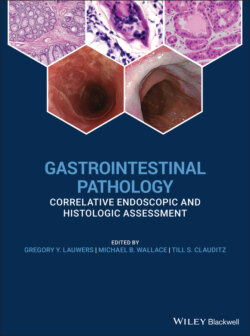Читать книгу Gastrointestinal Pathology - Группа авторов - Страница 47
Microscopic Features Candida
ОглавлениеThe biopsies typically show an active esophagitis with a mixed inflammatory infiltrate of neutrophils, lymphocytes, and eosinophils. Neutrophils are often present in small, superficial clusters associated with parakeratosis or squamous debris, which may be a diagnostic clue. Prominent intraepithelial neutrophils may be associated with abscesses, erosions, or ulcerations. The inflammatory response may be minimal in severely immunocompromised patients.
Yeast forms of C. albicans and pseudohyphae (with refractile cell walls) are usually present in superficial desquamated keratin debris (Figure 2.4). The yeast are 3–5 μm in diameter basophilic oval forms while the, nonseptate sausage‐like pseudohyphae are 3–5 μm in diameter and are arranged perpendicular to the epithelial surface. Occasional septate hyphae can be present. The presence of psuedohyphal and hyphal forms correlates with active infection. Most infections are superficial with isolated, intraepithelial fungal forms, and organisms in detached squamous cells. However, in immunocompromised hosts, deeper tissue invasion within ulcers and erosions may be seen. Candida are often conspicuous in routinely stained sections, although their appearance is enhanced with periodic acid–Schiff (PAS, Figure 2.5) or Grocott methenamine silver (GMS) stains. In Candida (Torulopsis) glabrata infections, only small budding yeast forms are seen, which may mimic histoplasmosis.
Figure 2.4 Debris of slough off superficial squamous epithelium with fungal hyphae and acute inflammation.
Figure 2.5 PAS stain of Figure 2.4 illustrating the fungal elements of Candida albicans.
Figure 2.6 Multinucleated basal keratinocytes typical of HSV esophagitis.
Candida can colonize preexisting ulcers or damaged mucosa of any etiology, and in such cases the possibility of dual infection or pathology should be considered. Also, when Candida yeast forms are present only in desquamated keratin debris unassociated with inflammation or endoscopic findings, carry over from an oral infection should be suspected. Cytologic brushings are also very useful in the diagnosis of Candida esophagitis, as the organisms are readily identified on Papanicolaou stained smears.
